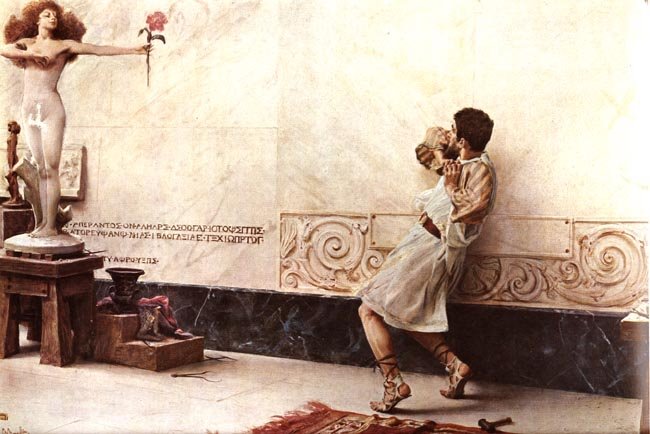




Yep, slaves, and of course mostly female slaves: a typical and slightly erotical -as usual- leitmotif of our beloved "pompiers".
Here, for your viewing and collecting pleasure: Buchser's naked slave, Boulanger's slave market, Cercone's examining slaves. I'll add Rosati's 'examining the new arrivals'.
Ok, I'll give you José Jimenez Aranda's "young slave" as well. But that's enough for today.
Enjoy.
Artists had more or less unlimited access to the bodies of the women who worked for them as models. In other words, their private fantasy exists not in a vacuum but in a particular social context, granting permission as well as establishing boundaries for certain kinds of behavior.
They attempted to defuse and distance their overt expression of man's total domination of women in a variety of ways, at the same time emphasizing the sexually provocative aspects of such themes. Note how in Boulanger's slave market the slave owner is eating cacahouettes with fantastic nonchalance in a lull pause.
It is obvious that by depicting such subjects with such obvious sensual relish, such erotic panache and such openness, the pompiers had come too close to an overt statement of the most explosive, hence the most carefully repressed, fantasy of the patriarchal discourse of desire.
The fantasy of absolute possession of women's naked bodies, a fantasy which for the nineteenth-century artist was at least in part a reality in terms of specific practice—the constant availability of studio models for sexual as well as professional needs—lies at the heart of inspired pictorial representations of Near Eastern Classical themes, like Gerome's Oriental Slave Market. In that case, of course, an iconographical representation of power relations coincides with, although it is not identical to, assumptions about male authority. Although ostensibly realistic representations of the customs of picturesque Orientals, such paintings are also suitably veiled affirmations of the fact that women are actually for sale to men for the latter's sexual satisfaction - in Paris just as in the Near East. Sexual practice is more successfully ideologized in this case than in previous paintings, and works like these appeared frequently in the Salons of the period, and were much admired.
Why was this the case? First of all they were acceptable because the style justifies the subjects, by guaranteeing through sober "objectivity" the unassailable otherness of the characters enacting such narratives. The artist is saying in effect: "Don't think that I, or any other right-thinking Frenchman, would ever be involved in this sort of thing. I am merely taking careful note of the fact that less enlightened races indulge in the trade in naked women—but isn't it arousing!".
And these images are infact quite arousing.
Such artists, like many other artists of his time, manage to body forth a double message here: one about men's power over women and the other about white man's superiority to, hence justifiable control over, darker and 'more savages' races — precisely those who indulge in this sort of lascivious trade. Maybe something more complex is involved in this approach vis-a-vis the 'homme moyen sensuel': the latter was invited sexually to identify with, yet at the same time morally to distance himself from, his Oriental counterparts within the objectively inviting yet racially distancing space of the painting.
The savage inside the viewer is artfully titillated.
Enjoy.

2 comments:
Thanks, you'r doing a very good work.
"Thanks, you'r doing a very good work."
Er, thanks :)
It's nice to see my scans being appreciated, even without any credit...
Post a Comment